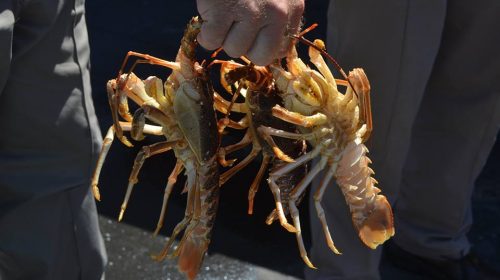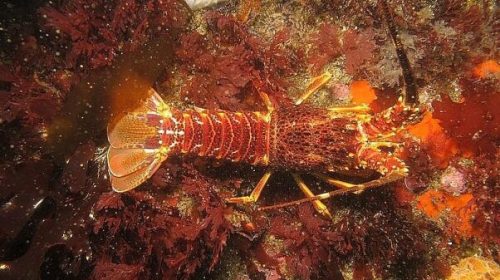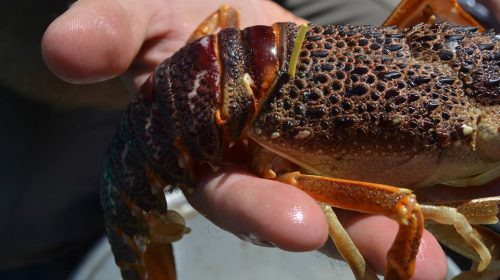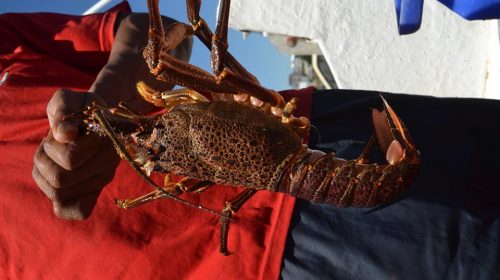While SASSI has officially red-listed and declared the West Coast lobster endangered species – this means do not buy or eat – there is new concern for an alleged fast-growing and lucrative trade in lobster eggs.
A Velddrif resident recently wrote in a local newspaper about alleged “huge orders” for at least 1 000 rock lobsters at a time that are easily caught overnight and sold to buyers in Cape Town. The latest trend is allegedly egg-carrying females (in berry) that can earn a lobster-fishermen up to R100 000 for a 2 litre ice cream container of lobster eggs.
Has lobster eggs now become the new “caviar” for snobbish foodies in trendy international hotels and restaurants? The writer asked how the West Coast rock lobster can be saved from total extinction if the beginning of life – the egg – is removed from the food chain link.
 Traditional West Coast fishermen who used to make a reasonably good living from fishing admit that they are seriously tempted by the lucrative smuggling and poaching businesses that are systematically destroying their livelihood and our marine life. It seems that these illegal syndicates are flourishing despite renewed attempts by international and governmental institutions to curb their activities.
Traditional West Coast fishermen who used to make a reasonably good living from fishing admit that they are seriously tempted by the lucrative smuggling and poaching businesses that are systematically destroying their livelihood and our marine life. It seems that these illegal syndicates are flourishing despite renewed attempts by international and governmental institutions to curb their activities.
Here are some interesting background information about the West Coast Rock Lobster and what consumers can do to help protect the species.
The photos were taken at the Yzerfontein harbour where tourists and visitors are treated to informative talks about the tagging of the West Coast lobster in order to gain essential information regarding its habits, habitats and reproduction cycle. (Photos: Social media and Thelma Nel)
The looming fate of the West Coast Rock Lobster – can I make a difference as a concerned consumer?
The reason for SASSI taking such drastic action is because the fishery is close to collapses. Why? Due to overfishing and increasing levels of illegal harvesting – stocks are presently at just 2.5% of their original size. If this fishery does collapse, it will have a significant impact not only on consumers who love this species but also on the livelihoods of both commercial and small-scale fishers.
Together with the Department of Agriculture, Forestry and Fisheries (DAFF), WWF-SA and other stakeholders have been collaborating on a Fisheries Conservation Project (FCP) for the WCRL fishery. The FCP aims to move the fishery back towards healthier stock levels and create the improvements needed to support a SASSI green listing in years to come.
So can I help as a concerned consumer?
Yes, Consumers can also play their part by following progress on this project and using their wallets to support the legal fishery. While the FCP is underway, look out for the “improvement icon” used by WWF-SASSI to indicate that an improvement project is underway for WCRL. Also when purchasing lobster make sure of the following:
For everyday consumers:
a. DO NOT purchase undersized or “baby” lobster, a legal size lobster should have a minimum size of 80mm – this is measured from the centre of the posterior edge of the carapace to the tip of the middle anterior spine.
b. DO NOT purchase lobsters in berry (with eggs on its tail) at all.
c. DO NOT buy lobsters from recreational fishers. Require any fisher who sells you lobster to show you a valid fishing permit. Do Not accept lobster sold under a recreational fishing permit or without any permit at all.
For recreational fishers:
a.If you would like to catch West Coast rock lobster, for personal consumption, a recreational fishing permit must be purchased from your local post office.
b. Recreational fisheries can only catch lobsters during lobster season, which opens in November 2016.
c. The bag limit is 4 lobsters per permit holder per day for own use. But think about how many you really need!
d.Lobsters in berry (with eggs on its tail), cannot be caught and must be returned to the sea immediately
e.No person must sell, barter or buy lobsters bought on a recreational permit
As a consumer and seafood lover, you can use your voice and your wallet to help rescue this species thereby allowing it to continue to persist in our oceans. For more information visit www.wwf.org.za/sassi
or download the SASSI app.WWF South Africa #SASSI #Sustainable #rocklobster

WWFSASSI.CO.ZA
Also read: (Copy and paste into url):
http://www.groundup.org.za/article/lobster-crash-erodes-west-coast-way-life/
CRAYFISH West Coast-South Africa

West Coast Crayfish
Cape Town and the West coast of the Cape Province are well known for their crayfish industry. Crayfish are found on the rocky seabeds and kelp beds along our coastline.Some live close inshore in cracks in rocks and in old jetties such as the one at Yzerfontein.
The West Coast crayfish has an interesting life-cycle and it takes from 7 to 10 years for a male crayfish to attain a catchable size of 65mm. Female crayfish may take up to 20 years to reach this size.
In days gone by the resource was plentiful but these days due to commercial exploitation it has become relatively scarce. There are reports that back in the times of Van Riebeeck that Hout Bay took on a red tinge because its bottom was carpeted with crayfish. If that is to be believed it is certainly not the case today.
In the 1800’s crayfish were regarded as pests and when caught in the fishermen’s nets they would simply toss them overboard again. Dead crayfish often washed up on the shores and wagon loads of them were collected and sold to farmers as fertiliser.
Back in the 1960’s I can remember my late father selling a hundred crayfish for R10.00 to a wholesaler. That same catch would be worth in excess of R5000.00 today if prices in the local restaurants are anything to go by.
There are a number of methods to catch crayfish. The most popular for the recreational fisherman is to dive for them. Swimming around in the kelp beds and looking under submerged rocks to see a feeler sticking out is the way it is done. When spotted the diver must pin the crayfish from behind around its carapace to prevent himself from being injured by the sharp spines of the crayfish or getting his fingers caught under the flapping tail.

Jetty at Ysterfontein
A crayfish walks forwards when on the seabed but when alarmed swims backward at speed by flapping its tail. An escaping cayfish is impossible to catch by hand.
Other methods and the one I used when a youngster was to have long pole with a two or three metres of nylon attached to it. At the end would be a piece of wire attached to the nylon with a number of limpets which had been chopped off the rocks threaded onto it and weighted with a sinker. You would then lower the limpets into a hole in the kelp standing on a rock as close as you could get to the kelp beds.
Every now and again you lifted the limpets to see if a crayfish had taken the bait. If there was a crayfish on the end of the line you would feel its weight and sometimes even its tug as it wrestled to get a limpet off your line. The trick to catch it was to lift the pole slowly bringing the crayfish to the surface so that it would not notice what was happening and then to slide your scoop net with its long handle under the crayfish and drop it into the net. Once in the net you simply lifted the net out of the water and you had your crayfish.
An old aunt of mine who was a real expert used a similar method except that she did away with the long pole. A longer piece of line was used and thrown out deeper into the kelp beds. When she felt a crayfish on her line she would wait for an incoming swell and pull the crayfish in a couple of metres with the swell After two or three swells the crayfish was at her feet still clinging to the bait and she would simply lift the bait and catch it and the crayfish in her short handled scoop net.
These days the knack of catching crayfish has been lost and most people use ringnets with fish heads as bait to catch them. The big problem with this method is that the nets often get stuck under rocks and become difficult to retrieve. Unfortunately due to the big commercial demand for crayfish the recreational fisherman has had his fun severely restricted.
Commercial fishermen get quotas and land thousands of seven to ten year old crayfish daily. The recreational fishermen is allowed a catch of four crayfish per day during a season of about four months. During the first two months he is allowed to catch crayfish daily and after the initial two months only on weekends and public holidays till the season ends and then only if he is in possession of a crayfish licence. It’s a crying shame.
What once used to be a staple meal for fishing communities along the west coast has now been taken from them as they are also classed as recreational fishermen unless thay have been granted a small quota. The bulk of the crayfish catch is granted to fishing companies who export most of it to the USA and Japan. Restaurants purchase what is not exported at what appears to be export prices.
Due to the above prices in restaurants are exhorbitant and only people with large wallets or those with foreign currency in their pockets can afford to pay for them. As for the rest of us the taste of crayfish is a long forgotten memory.
http://www.turtlesa.com/crayfish.html
DID YOU KNOW?
West Coast rock lobster (crayfish or ‘’kreef’’ as they are known locally) grow very slowly and can live to the ripe old age of 50 years or so.
A mysterious life-cycle
Female rock lobsters carry their orange eggs on tiny hairs beneath their tails (this is when they are “in berry”). After 80 to 90 days, the eggs hatch and produce tiny transparent spider-like larvae (naupliosoma). These larvae moult and become phyllosoma larvae with long, hairy legs.
All adrift
The long-legged phyllosomas drift with the ocean currents for over seven months and molt 11 times! It is thought that some of these larvae are carried by ocean currents all the way to South America and back.
The final larval stage (the puerulus) is a 20mm colourless lobster that swims inshore and finds refuge under a rock or a crevice where it continues to grow to maturity.
It is impossible to farm rock lobster because of this long and complex life-cycle.
Carnivores of the kelp forest
West Coast rock lobsters are an important link in the kelp forest food chain. As carnivores, they tuck into mussels, urchins, starfish, abalone (perlemoen), and even barnacles. Where they occur in masses, they have been known to devour entire populations of sea urchins, for example. However, rock lobsters are also a target for other kelp predators – they are hunted by octopuses, dogsharks, seals and humans.
Managing the West Coast rock lobster fishery
In earlier years, the South African rock lobster fishery would catch about 4 000 tonnes of lobster per year. The fishery has declined dramatically in recent years due to slow growth rates of the lobsters and illegal fishing activities.
Today, the commercial fishery harvests less than 2 000 tonnes of rock lobster, contributing about R200 million to the economy every year.
SASSI status – Red (don’t buy)
Recreational crayfishers
Over and above this catch, recreational fishers take out about 69 tonnes per year. This is a substantial amount and recreational fishers should make certain that they and others keep to the regulations. This will ensure that the fishery remains sustainable and that they can continue to enjoy this pastime in the future.
Support these regulations
Open season
Make sure you know when the season for West Coast rock lobster opens and only fish for them during this time.
Permit
Get a permit for West Coast rock lobster from your local post office.
Bag limit
Only four West Coast rock lobster are allowed per person per day. You may not sell your catch and you must transport the lobsters in their whole state.
Size limit
Only crayfish with a minimum size of 80mm may be removed from the sea.
Respect egg-carrying females
Your may not take out female lobsters that are in berry. Return them to the sea immediately.
For more information visit the Department of Environmental Affairs and Tourism website.
The impact of red tide
Red tide (decaying phytoplankton blooms) often occurs in areas where large numbers of West Coast rock lobster occur. Red tide causes oxygen levels to drop dramatically and the rock lobsters move inshore, searching for oxygenated water. They are often left stranded by the receding tide, resulting in what is mistakenly referred to as “rock lobster walkout”. In 1997 the largest ever stranding of rock lobster occurred in Elands Bay. An estimated 2 000 tons of rock lobster was lost as a result.
Species Facts
-
West Coast rock lobster populations have declined a lot in the past few decades, due to over-fishing and poaching
-
West Coast rock lobsters are carnivores and eat mussels, starfish, and abalone (perlemoen), among other things
-
When female rock lobsters are carrying eggs with them, they are “in berry”
-
It is impossible to farm rock lobsters because of their long and complex life-cycle
http://www.aquarium.co.za/species/entry/west_coast_rock_lobster
ALSO READ:
http://www.nefsc.noaa.gov/faq/fishfaq7.html




